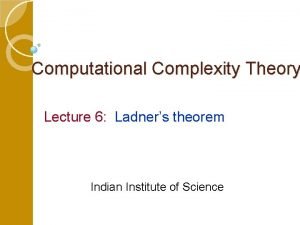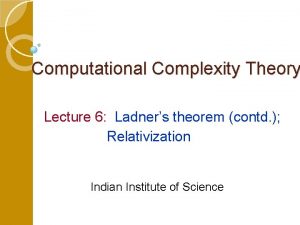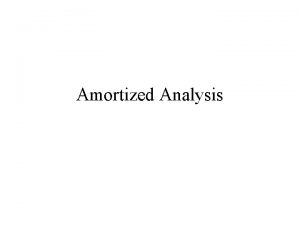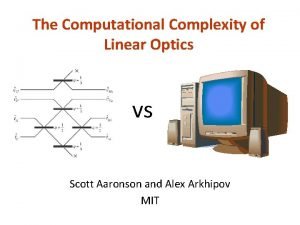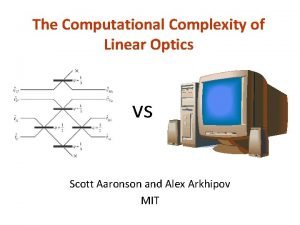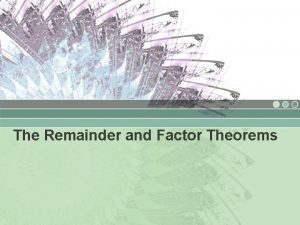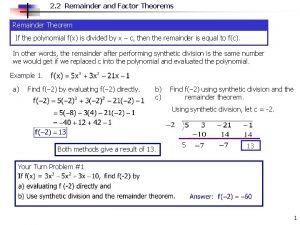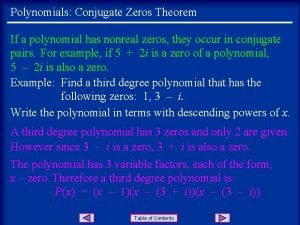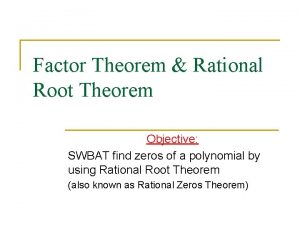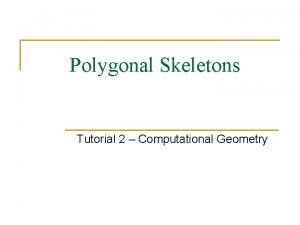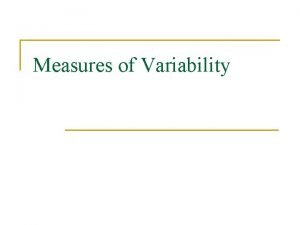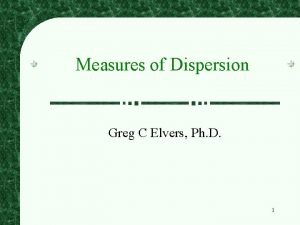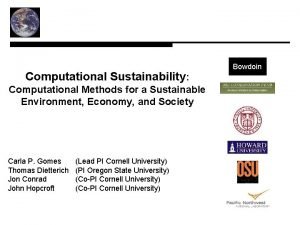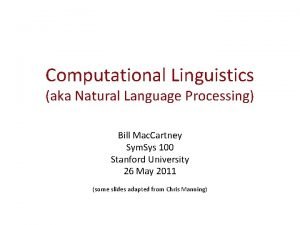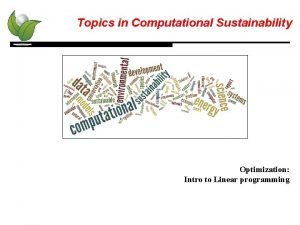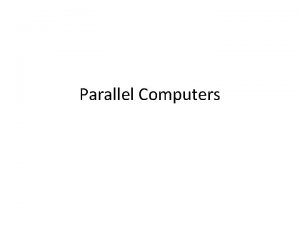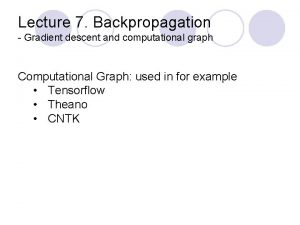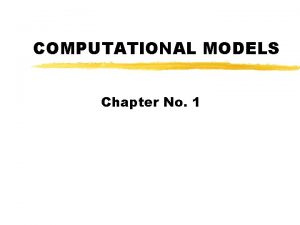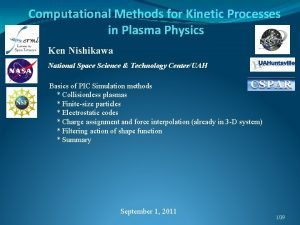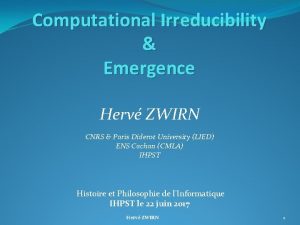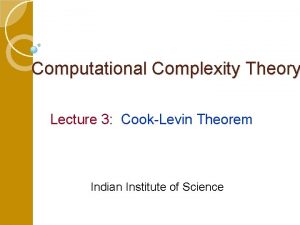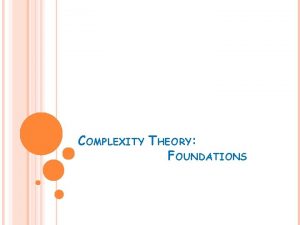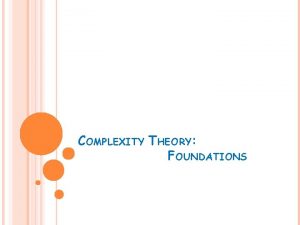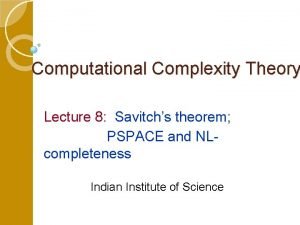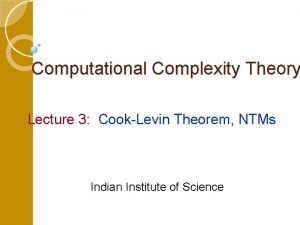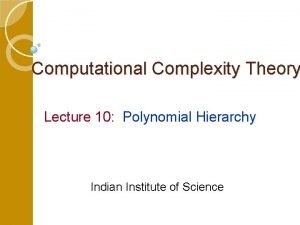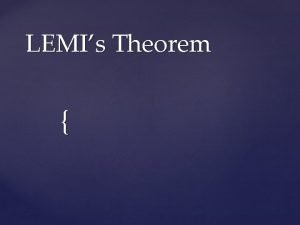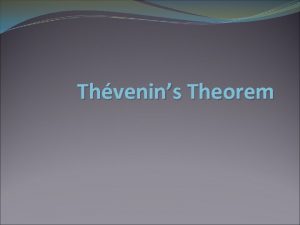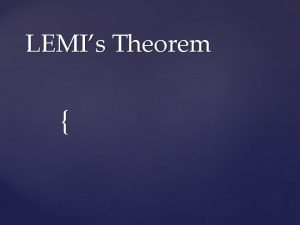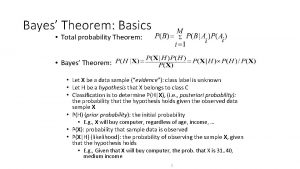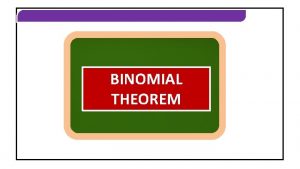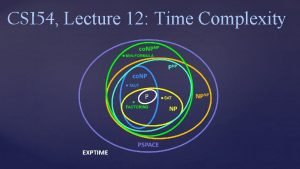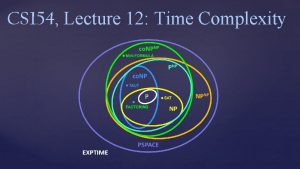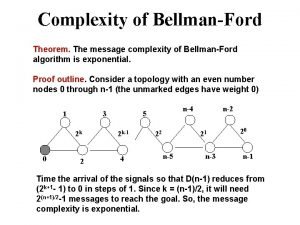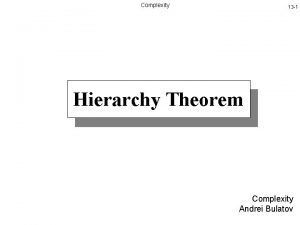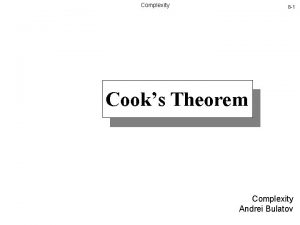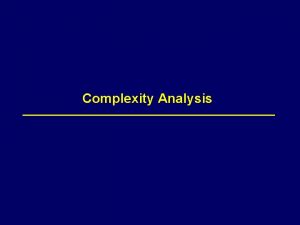Computational Complexity Theory Lecture 6 Ladners theorem Indian
















































- Slides: 48

Computational Complexity Theory Lecture 6: Ladner’s theorem Indian Institute of Science

Recap: Diagonalization �Diagonalization refers to a class of techniques used in complexity theory to separate complexity classes. �These techniques are characterized by two main features: 1. There’s a universal TM U that when given strings α and x, simulates Mα on x with only a small overhead. 2. Every string represents some TM, and every TM can be represented by infinitely many strings.

Recap: Time Hierarchy Theorem �Let f(n) and g(n) be time-constructible functions s. t. , f(n). log f(n) = o(g(n)). �Theorem. DTIME(f(n)) ⊊ DTIME(g(n)) P ⊊ EXP

Ladner’s Theorem - Another application of Diagonalization

NP-intermediate problems �Definition. A language L in NP is NPintermediate if L is neither in P nor NP-complete.

NP-intermediate problems �Definition. A language L in NP is NPintermediate if L is neither in P nor NP-complete. NPC NP-intermediate NP P

NP-intermediate problems �Definition. A language L in NP is NPintermediate if L is neither in P nor NP-complete. NPC NP P NP-intermediate (integer factoring, graph isomorphism ? ? )

NP-intermediate problems �Definition. A language L in NP is NPintermediate if L is neither in P nor NP-complete. … the notion makes sense only if P ≠ NP

NP-intermediate problems �Definition. A language L in NP is NPintermediate if L is neither in P nor NP-complete. �Theorem. (Ladner) If P ≠ NP then there is an NPintermediate language.

NP-intermediate problems �Definition. A language L in NP is NPintermediate if L is neither in P nor NP-complete. �Theorem. (Ladner) If P ≠ NP then there is an NPintermediate language. Proof. A delicate argument using diagonalization.

NP-intermediate problems �Definition. A language L in NP is NPintermediate if L is neither in P nor NP-complete. �Theorem. (Ladner) If P ≠ NP then there is an NPintermediate language. Proof. Let H: N N be a function.

NP-intermediate problems �Definition. A language L in NP is NPintermediate if L is neither in P nor NP-complete. �Theorem. (Ladner) If P ≠ NP then there is an NPintermediate language. Proof. Let H: N N be a function. Let m. H(m) SATH = {Ψ 0 1 : Ψ ∈ SAT and |Ψ| = m}

NP-intermediate problems �Definition. A language L in NP is NPintermediate if L is neither in P nor NP-complete. �Theorem. (Ladner) If P ≠ NP then there is an NPintermediate language. Proof. Let H: N N be a function. Let m. H(m) SATH = {Ψ 0 1 : Ψ ∈ SAT and |Ψ| = m} H would be defined in such a way that SATH is NPintermediate (assuming P ≠ NP )

Ladner’s theorem: Constructing H �Theorem. There’s a function H: N N such that 1. H(m) is computable from m in O(m 3) time

Ladner’s theorem: Constructing H �Theorem. There’s a function H: N N such that 1. H(m) is computable from m in O(m 3) time 2. SATH ∈ P H(m) ≤ C (a constant) for every m

Ladner’s theorem: Constructing H �Theorem. There’s a function H: N N such that 1. H(m) is computable from m in O(m 3) time 2. SATH ∈ P H(m) ≤ C (a constant) 3. If SATH ∉ P then H(m) ∞ with m

Ladner’s theorem: Constructing H �Theorem. There’s a function H: N N such that 1. H(m) is computable from m in O(m 3) time 2. SATH ∈ P H(m) ≤ C (a constant) 3. If SATH ∉ P then H(m) ∞ Proof: Later (uses diagonalization). with m

Ladner’s theorem: Proof P ≠ NP �Suppose SATH ∈ P. Then H(m) ≤ C.

Ladner’s theorem: Proof P ≠ NP �Suppose SATH ∈ P. Then H(m) ≤ C. �This implies a poly-time algorithm for SAT as follows:

Ladner’s theorem: Proof P ≠ NP �Suppose SATH ∈ P. Then H(m) ≤ C. �This implies a poly-time algorithm for SAT as follows: Ø On input ϕ , find m = |ϕ|.

Ladner’s theorem: Proof P ≠ NP �Suppose SATH ∈ P. Then H(m) ≤ C. �This implies a poly-time algorithm for SAT as follows: Ø On input ϕ , find m = |ϕ|. m. H(m) Ø Compute H(m), and construct the string ϕ 0 1

Ladner’s theorem: Proof P ≠ NP �Suppose SATH ∈ P. Then H(m) ≤ C. �This implies a poly-time algorithm for SAT as follows: Ø On input ϕ , find m = |ϕ|. m. H(m) Ø Compute H(m), H(m) and construct the string ϕ 0 1 m Ø Check if ϕ 0 1 belongs to SATH

Ladner’s theorem: Proof P ≠ NP �Suppose SATH ∈ P. Then H(m) ≤ C. �This implies a poly-time algorithm for SAT as follows: Ø On input ϕ , find m = |ϕ|. m. H(m) Ø Compute H(m), H(m) and construct the string ϕ 0 1 m Ø Check if ϕ 0 1 belongs to SATH length at most m + 1 + m. C

Ladner’s theorem: Proof P ≠ NP �Suppose SATH ∈ P. Then H(m) ≤ C. �This implies a poly-time algorithm for SAT as follows: Ø On input ϕ , find m = |ϕ|. m. H(m) Ø Compute H(m), H(m) and construct the string ϕ 0 1 m Ø Check if ϕ 0 1 �As belongs to SATH P ≠ NP, it must be that SATH ∉ P.

Ladner’s theorem: Proof P ≠ NP �Suppose SATH is NP-complete. Then H(m) ∞ with m.

Ladner’s theorem: Proof P ≠ NP �Suppose SATH is NP-complete. Then H(m) ∞ with m. �This also implies a poly-time algorithm for SAT: f SAT ≤p SATH ϕ Ψ 0 1 k

Ladner’s theorem: Proof P ≠ NP �Suppose SATH is NP-complete. Then H(m) ∞ with m. �This also implies a poly-time algorithm for SAT: f SAT ≤p SATH ϕ |ϕ| = n Ψ 0 1 k |Ψ 0 1 k| = nc

Ladner’s theorem: Proof P ≠ NP �Suppose SATH is NP-complete. Then H(m) ∞ with m. �This also implies a poly-time algorithm for SAT: f SAT ≤p SATH ϕ Ψ 0 1 k Ø On input ϕ, compute f(ϕ) = Ψ 0 1 k. Let m = |Ψ|.

Ladner’s theorem: Proof P ≠ NP �Suppose SATH is NP-complete. Then H(m) ∞ with m. �This also implies a poly-time algorithm for SAT: f SAT ≤p SATH ϕ Ψ 0 1 k Ø On input ϕ, compute f(ϕ) = Ψ 0 1 k. Let m = |Ψ|. Ø Compute H(m) and check if k = m. H(m).

Ladner’s theorem: Proof P ≠ NP �Suppose SATH is NP-complete. Then H(m) ∞ with m. �This also implies a poly-time algorithm for SAT: f SAT ≤p SATH ϕ Ψ 0 1 k Ø On input ϕ, compute f(ϕ) = Ψ 0 1 k. Let m = |Ψ|. Ø Compute H(m) and check if k = m. H(m). Either m is small (in which case the task reduces to checking if a small Ψ is satisfiable),

Ladner’s theorem: Proof P ≠ NP �Suppose SATH is NP-complete. Then H(m) ∞ with m. �This also implies a poly-time algorithm for SAT: f SAT ≤p SATH ϕ Ψ 0 1 k Ø On input ϕ, compute f(ϕ) = Ψ 0 1 k. Let m = |Ψ|. Ø Compute H(m) and check if k = m. H(m). or H(m) > 2 c (as H(m) tends to infinity with m).

Ladner’s theorem: Proof P ≠ NP �Suppose SATH is NP-complete. Then H(m) ∞ with m. �This also implies a poly-time algorithm for SAT: f SAT ≤p SATH ϕ Ψ 0 1 k Ø On input ϕ, compute f(ϕ) = Ψ 0 1 k. Let m = |Ψ|. Ø Compute H(m) and check if k = m. H(m). Ø Hence, w. lo. g. |f(ϕ)| ≥ m 2 c

Ladner’s theorem: Proof P ≠ NP �Suppose SATH is NP-complete. Then H(m) ∞ with m. �This also implies a poly-time algorithm for SAT: f SAT ≤p SATH ϕ Ψ 0 1 k Ø On input ϕ, compute f(ϕ) = Ψ 0 1 k. Let m = |Ψ|. Ø Compute H(m) and check if k = m. H(m). Ø Hence, w. l. o. g. nc = |f(ϕ)| ≥ m 2 c

Ladner’s theorem: Proof P ≠ NP �Suppose SATH is NP-complete. Then H(m) ∞ with m. �This also implies a poly-time algorithm for SAT: f SAT ≤p SATH ϕ Ψ 0 1 k Ø On input ϕ, compute f(ϕ) = Ψ 0 1 k. Let m = |Ψ|. Ø Compute H(m) and check if k = m. H(m). Ø Hence, √n ≥ m

Ladner’s theorem: Proof P ≠ NP �Suppose SATH is NP-complete. Then H(m) ∞ with m. �This also implies a poly-time algorithm for SAT: f SAT ≤p SATH ϕ Ψ 0 1 k Ø On input ϕ, compute f(ϕ) = Ψ 0 1 k. Let m = |Ψ|. Ø Compute H(m) and check if k = m. H(m). Ø Hence, √n ≥ m. Also ϕ ∈ SAT iff Ψ ∈ SAT

Ladner’s theorem: Proof P ≠ NP �Suppose SATH is NP-complete. Then H(m) ∞ with m. �This also implies a poly-time algorithm for SAT: f SAT ≤p SATH ϕ Ψ 0 1 k Ø On input ϕ, compute f(ϕ) = Ψ 0 1 k. Let m = |Ψ|. Ø Compute H(m) and check if k = m. H(m). Ø Hence, √n ≥ m. Also ϕ ∈ SAT iff Ψ ∈ SAT Thus, checking if an n-size formula ϕ is satisfiable reduces to checking if a √n-size formula Ψ is satisfiable.

Ladner’s theorem: Proof P ≠ NP �Suppose SATH is NP-complete. Then H(m) ∞ with m. �This also implies a poly-time algorithm for SAT: f SAT ≤p SATH ϕ Ψ 0 1 k Ø On input ϕ, compute f(ϕ) = Ψ 0 1 k. Let m = |Ψ|. Ø Compute H(m) and check if k = m. H(m). Ø Hence, √n ≥ m. Also ϕ ∈ SAT iff Ψ ∈ SAT Do this recursively! Only O(log n) recursive steps required.

Ladner’s theorem: Proof P ≠ NP �Suppose SATH is NP-complete. Then H(m) ∞ with m. �This also implies a poly-time algorithm for SAT: f SAT ≤p SATH ϕ Ψ 0 1 k Ø On input ϕ, compute f(ϕ) = Ψ 0 1 k. Let m = |Ψ|. Ø Compute H(m) and check if k = m. H(m). Ø Hence, √n ≥ m. Also ϕ ∈ SAT iff Ψ ∈ SAT � Hence SATH is not NP-complete, as P ≠ NP.

Ladner’s theorem: Properties of H �Theorem. There’s a function H: N N such that 1. H(m) is computable from m in O(m 3) time 2. SATH ∈ P H(m) ≤ C (a constant) 3. If SATH ∉ P then H(m) �SATH m. H(m) = {Ψ 0 1 ∞ with m : Ψ ∈ SAT and |Ψ| = m}

Construction of H �Observation. The value of H(m) determines membership in SATH of strings whose length is ≥ m. �Therefore, it is OK to define H(m) based on strings in SATH whose length is < m (say, log m).

Construction of H �Observation. The value of H(m) determines membership in SATH of strings whose length is ≥ m. �Therefore, it is OK to define H(m) based on strings in SATH whose length is < m (say, log m). �Construction. H(m) is the smallest k < log m s. t. 1. Mk decides membership of all length up to log m strings x in SATH within k. |x|k time.

Construction of H �Observation. The value of H(m) determines membership in SATH of strings whose length is ≥ m. �Therefore, it is OK to define H(m) based on strings in SATH whose length is < m (say, log m). �Homework. Prove that H(m) is computable from m in O(m 3) time.

Construction of H �Claim. If SATH ∈ P then H(m) ≤ C (a constant). �Proof. There is a poly-time M that decides membership of every x in SATH within c. |x|c time.

Construction of H �Claim. If SATH ∈ P then H(m) ≤ C (a constant). �Proof. There is a poly-time M that decides membership of every x in SATH within c. |x|c time. �As M can be represented by infinitely many strings, there’s anα ≥ c s. t. M = Mα decides membership of every x in SATH within α. |x|α time. �So, for every m satisfying α < log m, H(m) ≤ α.

Construction of H �Claim. If H(m) ≤ C (a constant) then SATH ∈ P. �Proof. There’s a k ≤ C s. t. H(m) = k for infinitely many m.

Construction of H �Claim. If H(m) ≤ C (a constant) then SATH ∈ P. �Proof. There’s a k ≤ C s. t. H(m) = k for infinitely many m. �Pick any x ∈ {0, 1}*. Think of a large enough m s. t. |x| ≤ log m and H(m) = k.

Construction of H �Claim. If H(m) ≤ C (a constant) then SATH ∈ P. �Proof. There’s a k ≤ C s. t. H(m) = k for infinitely many m. �Pick any x ∈ {0, 1}*. Think of a large enough m s. t. |x| ≤ log m and H(m) = k. �This means x is correctly decided by Mk in k. |x|k time. So, Mk is a poly-time machine deciding SATH.

Natural NP-intermediate problem? �Integer factoring. FACT = {(N, U): there’s a prime ≤ U dividing N} �Claim. �So, NP. FACT ∈ NP ∩ co-NP FACT is NP-complete if and only if NP = co-
 Ladner theorem
Ladner theorem Baker gill solovay
Baker gill solovay Amortized time big o
Amortized time big o The computational complexity of linear optics
The computational complexity of linear optics The computational complexity of linear optics
The computational complexity of linear optics For loop space complexity
For loop space complexity Green's theorem vs stokes theorem
Green's theorem vs stokes theorem 01:640:244 lecture notes - lecture 15: plat, idah, farad
01:640:244 lecture notes - lecture 15: plat, idah, farad Cognitive complexity theory in hci examples
Cognitive complexity theory in hci examples Comprehension psychology
Comprehension psychology Kavitha chunchu md
Kavitha chunchu md Cognitive complexity theory in hci rules
Cognitive complexity theory in hci rules Natural language processing nlp - theory lecture
Natural language processing nlp - theory lecture Bayesian decision theory lecture notes
Bayesian decision theory lecture notes Sargur srihari
Sargur srihari Natural language processing nlp - theory lecture
Natural language processing nlp - theory lecture Factor theorm
Factor theorm Factor theorem
Factor theorem Factor theorem and remainder theorem
Factor theorem and remainder theorem Conjugate theorem
Conjugate theorem Rational root theroum
Rational root theroum Linear factors theorem and conjugate zeros theorem
Linear factors theorem and conjugate zeros theorem Characteristics of computational thinking
Characteristics of computational thinking Computational thinking algorithms and programming
Computational thinking algorithms and programming Grc computational chemistry
Grc computational chemistry Using mathematics and computational thinking
Using mathematics and computational thinking Computational geometry tutorial
Computational geometry tutorial Computational neuroscience usc
Computational neuroscience usc Standard deviation computational formula
Standard deviation computational formula Standard deviation computational formula
Standard deviation computational formula Computational math
Computational math Algorithmic thinking gcse
Algorithmic thinking gcse Computational sustainability cornell
Computational sustainability cornell Chomsky computational linguistics
Chomsky computational linguistics Xkcd computational linguistics
Xkcd computational linguistics Comp bio cmu
Comp bio cmu Dsp computational building blocks
Dsp computational building blocks Computational sustainability subjects
Computational sustainability subjects Leerlijn computational thinking
Leerlijn computational thinking Computational demand
Computational demand Computational graph
Computational graph Computational graph
Computational graph Computational thinking jeannette m wing
Computational thinking jeannette m wing Hms research computing
Hms research computing Computational photography uiuc
Computational photography uiuc Computational neuroethology
Computational neuroethology Computational model in computer architecture
Computational model in computer architecture Computational methods in plasma physics
Computational methods in plasma physics Computational irreducibility
Computational irreducibility
